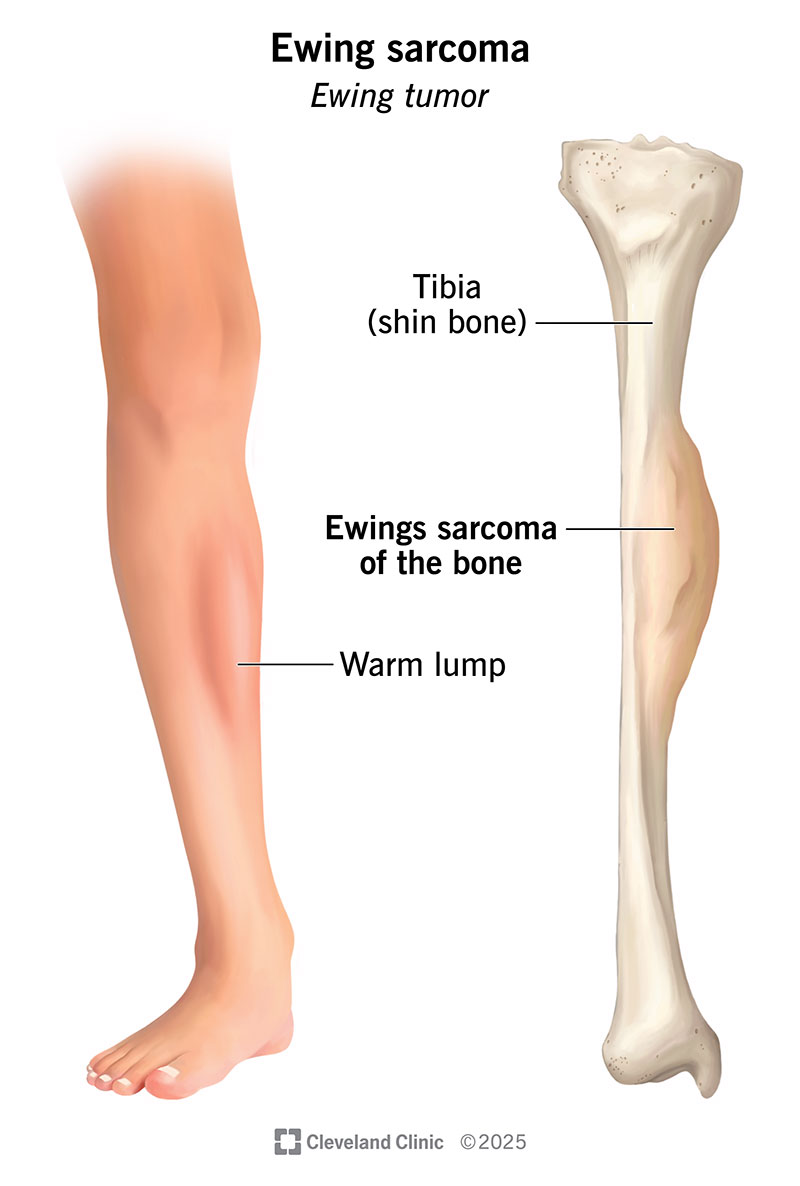Ewing sarcoma is a group of rare cancerous tumors in your bones or your soft tissues. The conditions typically affect people age 10 to 20. Symptoms are bone pain, swollen areas on your bones or lumps that feel warm to the touch. Treatment is chemotherapy followed by surgery to remove the tumors.
Advertisement
Cleveland Clinic is a non-profit academic medical center. Advertising on our site helps support our mission. We do not endorse non-Cleveland Clinic products or services. Policy

Ewing sarcoma refers to rare cancerous tumors in your bones and soft tissues like your muscles, tendons and ligaments. The condition, which is also known as Ewing tumor or Ewing’s sarcoma, may start in your hip, ribs or shoulder blades, thighbone or shinbone.
Advertisement
Cleveland Clinic is a non-profit academic medical center. Advertising on our site helps support our mission. We do not endorse non-Cleveland Clinic products or services. Policy
The tumors often develop during puberty, when your bones are growing very quickly. It typically affects people between ages 10 and 20, with most people receiving a diagnosis at age 15. But Ewing sarcoma may affect younger children and people in their late 20s to early 30s.
There are three types of Ewing sarcoma:
Ewing sarcoma may look like a bump or lump on your arms, legs or chest. Other symptoms that you or your child could have include:
A genetic mutation (change) that happens after you’re born causes Ewing sarcoma. The change involves the EWSR1 gene and the FLI1 gene. The two genes fuse to create a new gene that causes cells to multiply and create cancerous tumors.
Advertisement
Researchers don’t know what triggers the change. But they’ve ruled out exposure to carcinogens that cause other types of cancer. That’s because Ewing sarcoma typically affects children and young adults who don’t experience long-term exposure to substances that can cause cancer.
A risk factor is something that can increase your risk of getting cancer or other diseases. The American Cancer Society lists the following risk factors for Ewing sarcoma:
Ewing sarcoma complications include cancer that spreads, comes back after treatment or a second cancer. A second cancer is a new and different cancer.
Your child may experience late effects. These are health issues that your child may have months or years after they complete treatment. Cancer and cancer treatment may lead to issues with your child’s:
Healthcare providers will do a physical exam. They may feel for any lumps or bumps. They’ll ask about your symptoms. Tests to diagnose Ewing sarcoma may include:
Chemotherapy is a common initial or first treatment, followed by surgery to remove the tumor. You may have more chemotherapy or radiation therapy after surgery. Other treatments are radiation therapy or surgery. An autologous stem cell transplant is a treatment option if the cancer isn’t in your bone marrow.
If your child has Ewing sarcoma, their provider may recommend that you consider enrolling them in a clinical trial. A clinical trial is research that studies new ways to treat diseases like Ewing sarcoma. Medical researchers test new treatments or combinations of existing treatments to see if the treatments are safe and effective.
Advertisement
A lot goes into the clinical trial process. You’ll probably have many questions about that process and how a trial may benefit your child. Take time to understand the benefits and potential risks. Your child’s cancer care team is a great resource if you’re considering this treatment option for your child.
Talk to your cancer care team if you or your child has:
Cancer survival rates vary depending on the cancer’s location at diagnosis. According to the American Cancer Society, Ewing sarcoma survival rates are:
Survival rate data can be confusing and make you feel anxious. Try to keep in mind that survival rates are estimates that reflect others’ experiences. It’s natural to be concerned and have questions. Your child or your cancer care team understands all those feelings. They’ll take time to explain what survival rate data means in your or your child’s case.
Advertisement
Your child’s needs will change as they go through diagnosis, treatment and the rest of their life. For example, Ewing sarcoma typically happens around the time children start puberty. Puberty may feel like you and your teenager are on an emotional rollercoaster with sudden and unexpected twists and turns. A cancer diagnosis may put that emotional rollercoaster into overdrive.
Apart from feeling anxious about their health and coping with side effects, teenagers with Ewing sarcoma may feel frustrated about missing out on everyday activities at school and spending time with friends. They may also feel self-conscious about treatment side effects.
Try to be patient with your child and with yourself. Cancer can turn family life upside down, particularly if it’s cancer in your child. If you or your child feels overwhelmed, reach out to the child life specialist on your child’s care team. They’ll give you and your child helpful support and information.
A cancer diagnosis is tough at any age. But it can be especially hard when it’s Ewing sarcoma. This rare condition typically affects people ages 10 to 20. If you have this condition, you may worry about how treatment will affect you. If your child has this condition, you may feel afraid for your child and overwhelmed by their situation.
Advertisement
Your cancer care team understands those feelings, whether you’re living with Ewing sarcoma or your child has the condition. They know this rare disease is a life-changing event. They’ll take time to explain your diagnosis and treatment options. And they’ll be there for you or your child from diagnosis to treatment and beyond.
A Ewing sarcoma diagnosis can be life-changing. But Cleveland Clinic Children’s can help your child with personalized bone cancer treatments.

Last reviewed on 08/27/2025.
Learn more about the Health Library and our editorial process.